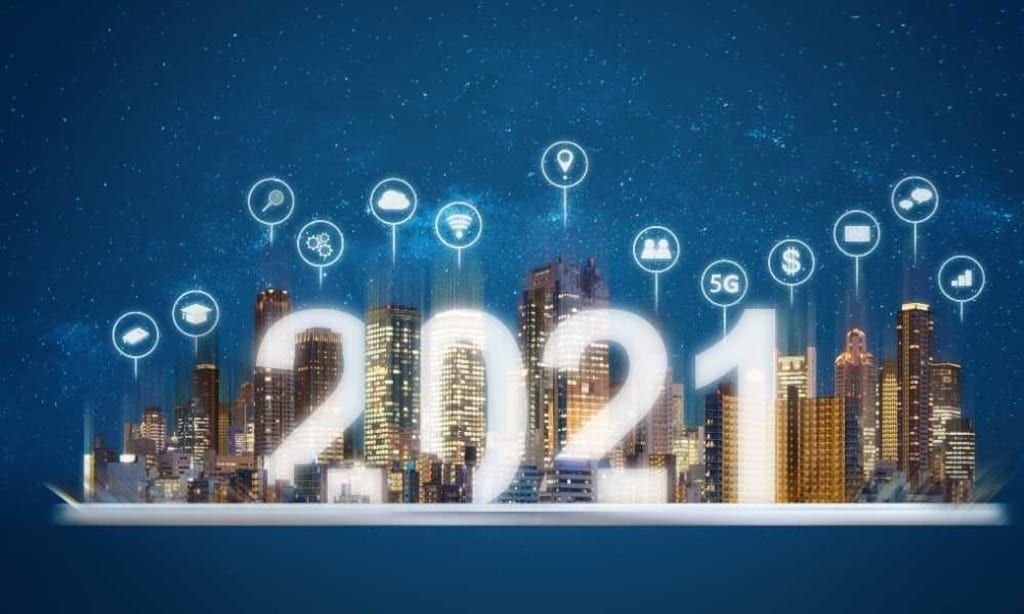Top 9 New Technology Trends for 2021
New technology trends to keep an eye on

Technology today is developing rapidly that it enables quick change and growth, allowing the rate of change to accelerate to the point that it will eventually become exponential. However, it is not just technology trends and top technologies that are changing; much more has changed this year because of the outbreak of COVID-19, which has made IT professionals realise that their position in tomorrow’s contactless world will not be the same. In 2020-21, an IT specialist will continuously study, unlearning, and relearning (out of necessity if not desire).
What does this suggest for you personally? It entails keeping up with new technological developments. It also entails keeping an eye on the future to determine which skills you’ll need to secure a secure job tomorrow, as well as learning how to get there. Because of the worldwide pandemic, most global IT workforce is staying at home. And if you want to make the most of your time at home in 2021, here are the top 9 new technology trends to keep an eye on and secure one of the jobs that these trends will generate.
Artificial Intelligence, or AI, has created a lot of hype over the last decade. Still, it remains one of the hottest emerging technology developments because of its significant impacts on how we live, work, and play. AI is now well-known for its dominance in image and speech recognition, navigation apps, mobile personal assistants, ride-sharing apps, and a wide range of other applications.
Aside from that, AI would be used to evaluate interactions to discover underlying links and observations, to forecast demand for facilities such as hospitals, allowing authorities to make better resource allocation decisions, and to identify evolving trends of consumer behaviour by analysing data in near real-time, resulting in increased revenues and customised experiences.
By 2025, the AI market will be worth $190 billion, with global spending on cognitive and AI systems exceeding $57 billion in 2021. New jobs will be generated in development, programming, testing, support, and maintenance, to name a few, as AI spreads across sectors. On the other hand, AI pays some of the highest wages today, with salaries ranging from over $1,25,000/year (machine learning engineer) to $145,000 per year (AI architect), making it the top new technology trend to keep an eye on.
Machine Learning, a subset of AI, is being used in various industries, resulting in high demand for professional employees. According to Forrester, AI, machine learning, and automation will generate 9% of new employment in the United States by 2025, including robot control experts, data scientists, automation specialists, and content curators, making it another new technology development; to be aware of!
Robotic Process Automation, or RPA, is a technology that automates work like AI and Machine Learning. RPA uses software to automate business processes such as application interpretation, transaction processing, data management, and even email response. RPA automates activities that previously required human intervention.
RPA automation, according to Forrester Research, would threaten the employment of 230 million or more knowledge employees, or around 9% of the global workforce. However, RPA is also generating new jobs while changing existing ones. According to McKinsey, only about 5% of jobs can be fully automated, but about 60% can be partially automated.
RPA provides a range of job opportunities for IT professionals looking to the future and seeking to grasp emerging technology trends, including developer, project manager, market analyst, solution architect, and consultant. And these are well-paying careers. RPA developers will gain more than $534K a year, making it the next and new technology trend to keep an eye on.
Cloud computing, which was once a cutting-edge technology development to keep an eye on, has become commonplace, with major players such as Amazon Web Services (AWS), Microsoft Azure, Google Cloud Platform, and GoDaddy leading the market. Cloud computing adoption continues to rise if more companies move to a cloud solution. However, it is no longer a new technology trend. It’s called the edge.
Organizations have acknowledged the drawbacks of cloud computing in certain cases as the amount of data they deal with expands. Edge computing is intended to address some of these concerns by eliminating the delay caused by cloud computing and allowing data to be sent directly to a data centre for processing. It can exist “on edge,” as it were, closer to the point where computing is needed. As a result, edge computing can be used to process time-sensitive data in remote areas where access to a centralised location is restricted or non-existent. Edge computing will serve as a mini data centre in these circumstances.
Edge computing will become more prevalent as the number of Internet of Things (IoT) devices grows. The global demand for edge computing is projected to hit $6.72 billion by 2022. And this latest technological trend will only continue to expand, generating several jobs, mainly for software engineers.
Quantum computing, a form of computing that takes advantage of quantum phenomena like superposition and quantum entanglement, is the next notable and new technology trend. Because of its ability to quickly query, track, interpret, and act on data from any source, this impressive technology trend is also involved in preventing the coronavirus’s spread and developing potential vaccines. Banking and finance are areas where quantum computing is used to handle credit risk, high-frequency trading, and fraud detection.
Quantum computers are now faster than standard computers, and big companies such as Splunk, Honeywell, Microsoft, AWS, Google, and others are focusing on quantum computing technologies. By 2029, the global quantum computing market is expected to be worth more than $2.5 billion. And you’ll need experience with quantum mechanics, linear algebra, probability, information theory, and machine learning to make a name for yourself in this new trending technology.
Virtual Reality (VR), Augmented Reality (AR), and Extended Reality (ER) are the next great technological trends (ER). AR improves the user’s environment while VR immerses them in it. While this technology trend has mainly been used for gaming, it has also been used for training, such as VirtualShip, a simulation software used to train ship captains in the United States Navy, Army, and Coast Guard.
We should expect these innovations to become much more incorporated into our lives by 2021. AR and VR have immense potential in training, entertainment, education, marketing, and even injury recovery. They usually work in combination with some of the other emerging technologies we’ve discussed in this list. Both may be used to teach doctors how to perform surgery, give museum guests a more immersive experience, improve theme parks, or even improve marketing, as in this Pepsi Max bus shelter.
In 2019, 14 million augmented reality and virtual reality systems were sold. By 2022, the global AR and VR market is projected to hit $209.2 billion, resulting in more opportunities in the trending technology and more professionals prepared to enter this game-changing sector.
Although some employers can require optics as a skill set, bear in mind that getting started in VR doesn’t necessitate a lot of advanced expertise – simple programming skills and a forward-thinking mentality are enough to land a job; another reason why this emerging technology trend should be on your radar!
While most people associate blockchain technology with cryptocurrencies like Bitcoin, it also protects various ways. In its most basic form, blockchain is data that you can only add to, not subtract from or alter. Since you’re building a data chain, the word “chain” was coined. The fact that previous blocks cannot be modified makes it so safe. Furthermore, since blockchains are consensus-based, no individual can monitor the data. You don’t need a trustworthy third party to oversee or verify transactions with blockchain.
Several industries are involving and introducing blockchain technology, and as the need for qualified practitioners grows, so does the demand for blockchain technology. A blockchain expert in creating and integrating blockchain-based architecture and solutions from a bird’s eye view. A blockchain developer’s average annual salary is about (Approximately)$469,000.
If you’re interested in Blockchain and its applications and want to pursue a career in this rapidly growing technology, now is the time to get started. You’ll need hands-on experience with programming languages, OOPS basics, flat and relational databases, data structures, web app creation, and networking to get into Blockchain.
IoT is another promising emerging technology trend. Many “things” now have WiFi connectivity, allowing them to link to the Internet—and one another. As a result, the Internet of Things, or IoT, was born. The Internet of Things (IoT) is the wave of the future, and it has already allowed computers, home appliances, vehicles, and much more to link to the Internet and share data.
We are already using and benefiting from IoT as users. We can lock our doors remotely if we fail to do so before leaving for work, and we can preheat our ovens on our way home from work, all while keeping track of our health with Fitbits. On the other hand, businesses have a lot to gain right now and shortly. As data is collected and analyzed, the IoT will help businesses improve their safety, performance, and decision-making. It has the potential to allow predictive maintenance, enhance medical care, and provide benefits we haven’t even considered.
And we’re just getting started with this new technology trend: According to estimates, about 50 billion IoT devices would be in use around the world by 2030, resulting in a vast network of devices interconnected like smartphones as well as kitchen appliances. In 2022, the global Internet of Things (IoT) investment is expected to hit 1.1 trillion dollars. In the coming years, innovations such as 5G are expected to boost market growth.
If you want to work in this hot field, you’ll need to learn about AI, security, machine learning basics, hardware interfacing, networking, data analytics, automation, embedded systems understanding, and computer and design expertise.
Following the IoT, 5G is the next technological trend to emerge. Whereas 3G and 4G technologies allowed us to access the internet, use data-driven services, increase bandwidth for streaming on Spotify or YouTube, and much more, 5G services are expected to transform our lives fully. Support services focused on emerging technology such as augmented reality and virtual reality and cloud-based gaming services like Google Stadia, NVidia GeForce Now, and others. It is planned to be used in factories, high-definition cameras that aid in traffic management and protection, smart grid control, and smart retail.
Almost every telecom firm, including Verizon, T-Mobile, Apple, Nokia Corp., and Qualcomm, is developing 5G applications. 5G networks are set to begin globally in 2021, with more than 50 providers providing services in about 30 countries by the end of the year, making it a new technology development to keep an eye on and save a spot for.
Given its long history, cybersecurity does not seem to be an emerging technology, but it is developing at the same pace as other technologies. This is partly because threats are continually evolving. Malevolent hackers seeking to access data unlawfully will not give up easily, and they will try to find ways to bypass even the most stringent protection measures. It’s also due to modern technologies’ adoption to improve the defense. Since cybersecurity will continue to protect against hackers as long as we have them, it will remain a popular technology.
Cybersecurity jobs are rising three times faster than other tech jobs, demonstrating the high demand for cybersecurity professionals. Furthermore, the need for proper cyber protection is so great that $6 trillion will be spent on cybersecurity globally by 2021.
It would help if you kept in mind that, as difficult as the profession is, it also pays well, with positions ranging from the ethical hacker to security engineer to Chief Security Officer, providing a promising career path for those interested in getting into and sticking with this evergreen trending technology.
Even though innovations are continually changing and emerging worldwide, these top 9 technology trends offer exciting job prospects now and in the future. And since most of these trending innovations are looking for qualified practitioners, now is the time to pick one, get prepared, and jump on board while they’re still in the early stages, putting you in a position to succeed now and in the future.
Source: Top 9 New Technology Trends for 2021
About the Creator
Abdul Majid Qureshi
Greetings, I’m Abdul Majid. I’m a writer living in Pakistan. I am working in tech journalism as a writer, editor and reviewer for over 4 years. I have reviewed many products ranging from smartphones, laptops, tablets to PC accessories.






Comments
There are no comments for this story
Be the first to respond and start the conversation.